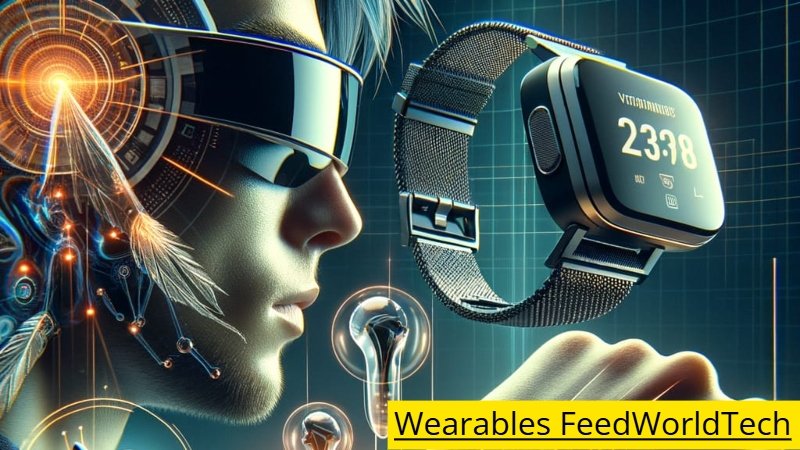Wearable technology has evolved far beyond simple fitness trackers. Today, devices seamlessly integrate health monitoring, artificial intelligence (AI), augmented reality (AR), virtual reality (VR), and smart textiles, providing personalized insights that enhance everyday life. Wearables FeedWorldTech represents the forefront of this evolution, tracking innovations that redefine how technology interacts with humans. From proactive healthcare to immersive experiences, these devices are reshaping productivity, wellness, and lifestyle.
In this guide, we provide a comprehensive look at wearable technology in 2025, including emerging trends, real-world applications, market insights, and future opportunities.
1. Health-Focused Wearables: Proactive Monitoring
Modern wearables prioritize health and wellness over mere activity tracking. Advanced devices monitor vital signs, detect anomalies, and provide actionable insights for a healthier lifestyle.
Key Features:
-
Real-time vital tracking: Heart rate, oxygen saturation, ECG, glucose, and stress metrics.
-
Sleep analysis: Monitors cycles, REM stages, and sleep quality for actionable recommendations.
-
Chronic disease support: Alerts users to irregular patterns, enabling early intervention.
Example: A smartwatch with ECG capabilities can detect arrhythmias and send alerts to both users and healthcare providers.
Benefits:
-
Early detection and preventive healthcare.
-
Personalized wellness recommendations.
-
Integration with telemedicine platforms.
Challenges:
-
Sensor accuracy and reliability.
-
Data privacy and regulatory compliance.
2. AI-Powered Wearables: Smarter Decisions
Artificial intelligence enhances the functionality of wearables by providing personalized insights and predictive analytics.
Applications:
-
AI fitness coaches: Analyze activity, heart rate, and recovery to optimize workouts.
-
Predictive health analytics: Suggest diet, hydration, and sleep improvements.
-
Lifestyle automation: Syncs with smart homes for environment adjustments based on user activity or health signals.
Advantages:
-
Personalized recommendations for health and productivity.
-
Reduces decision fatigue through actionable insights.
-
Enhances user engagement with adaptive learning.
Considerations:
-
Protecting sensitive health and behavioral data.
-
Avoiding information overload for the user.
3. AR and VR Wearables: Immersive Interactions
AR and VR devices are redefining how we interact with information and the physical world.
Applications:
-
Industrial and workplace training: Hands-free instruction and real-time guidance.
-
Education: Immersive learning through simulations.
-
Entertainment and gaming: Real-world overlays and interactive experiences.
Advantages:
-
Hands-free access to critical information.
-
Improved learning outcomes and efficiency.
-
Engaging consumer experiences for both entertainment and fitness.
Challenges:
-
Battery life and ergonomics.
-
Social acceptance and privacy concerns.
4. Smart Textiles and Biometric Clothing
Wearables are no longer limited to wrists and glasses. Smart textiles integrate sensors into clothing to monitor physiological metrics discreetly.
Examples:
-
Posture-correcting garments: Provide real-time feedback for spine alignment.
-
Sports apparel: Track calories, heart rate, and muscle activation.
-
Medical garments: Continuous monitoring in hospitals or home care.
Benefits:
-
Continuous, unobtrusive health tracking.
-
Integration of style and functionality.
-
Enables personalized recommendations for wellness and rehabilitation.
Challenges:
-
Washability and durability.
-
Cost of integrating electronics into everyday apparel.
5. Sustainability and Ethical Wearables
Environmental impact is increasingly important in wearable technology. Companies are adopting eco-friendly materials, modular components, and energy-efficient designs.
Trends:
-
Modular smartwatches and glasses: Replace components instead of entire devices.
-
Low-power sensors and rechargeable designs: Reduce energy consumption.
-
Socially responsible wearables: Devices designed to improve mental health, elder care, or public safety.
Advantages:
-
Minimizes e-waste and environmental impact.
-
Aligns with consumer demand for responsible technology.
-
Encourages long-term adoption and loyalty.
Challenges:
-
Higher manufacturing costs.
-
Educating users about sustainable practices.
6. Market Insights and Growth Forecast
The global smart wearable market is projected to grow from $85 billion in 2025 to $506 billion by 2035, at a CAGR of 19.5%. Key drivers include:
-
Rising adoption of AI-enabled health devices.
-
Increasing popularity of AR/VR wearables.
-
Expansion of smart textile and biometric clothing markets.
Regional Trends:
-
North America: Leader in innovation and adoption, especially in healthcare and fitness devices.
-
Europe: Focused on healthcare integration and sustainability.
-
Asia-Pacific: Rapid growth due to rising disposable income, manufacturing capacity, and tech adoption.
Emerging Opportunities:
-
Brain-computer interface (BCI) wearables.
-
Solar-powered and biodegradable devices.
-
Emotion recognition and metabolic tracking wearables.
Challenges:
-
Device affordability.
-
Battery limitations and data security.
-
Regulatory approvals for medical-grade wearables.
7. Comparison of Top Wearable Technologies
| Trend | Benefits | Challenges | Example |
|---|---|---|---|
| Health Monitoring | Early detection, remote monitoring | Sensor accuracy, privacy | ECG smartwatch |
| AI Ecosystems | Personalized insights, proactive health | Data security | AI fitness coach |
| AR/VR Glasses | Hands-free info, immersive learning | Comfort, battery | AR training glasses |
| Smart Textiles | Continuous monitoring, style | Washability, cost | Posture-correcting shirt |
| Sustainability | Eco-friendly, modular | Production cost | Recyclable smartwatch |
8. Future Outlook: What’s Next for Wearables
Wearables FeedWorldTech predicts the following trends shaping 2025–2035:
-
Integration of AI and BCI: Devices reading brain signals for adaptive interaction.
-
Expanded health diagnostics: Wearables capable of detecting chronic conditions and infections.
-
Seamless smart ecosystems: Full integration with IoT devices, homes, and healthcare infrastructure.
-
Sustainability focus: Devices using biodegradable materials and energy-efficient designs.
-
Global accessibility: Affordable wearables enabling health monitoring in developing regions.
FAQ: Wearables FeedWorldTech
Q1: What makes wearables feedworldtech unique?
A: It combines health monitoring, AI, AR/VR, smart textiles, and sustainability, offering a holistic wearable ecosystem.
Q2: Are AI-powered wearables safe for personal data?
A: Yes, with encrypted communication and GDPR-compliant practices, user data remains secure.
Q3: How do smart textiles improve daily life?
A: They provide unobtrusive health and performance monitoring while blending into everyday clothing.
Q4: Will wearable technology replace traditional healthcare?
A: No, wearables complement healthcare by enabling preventive monitoring and actionable insights.
Q5: Which wearable trend is growing fastest?
A: AI-powered health wearables and AR/VR glasses are seeing rapid adoption globally.
Conclusion
Wearables FeedWorldTech represents the future of smart devices, combining AI, AR, VR, smart textiles, and sustainable design to improve health, productivity, and lifestyle. These technologies are no longer just gadgets—they are intelligent companions that enhance daily life. Click here for more information.
Consumers, businesses, and healthcare providers who adopt these innovations will thrive in a connected, data-driven world. Staying informed through platforms like Wearables FeedWorldTech ensures you remain at the cutting edge of technology in 2025 and beyond.


